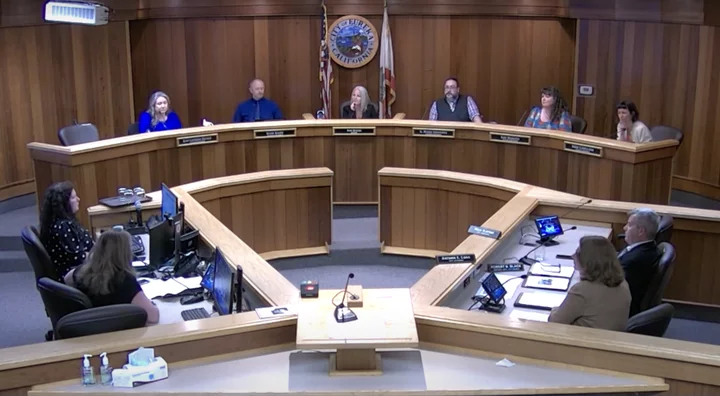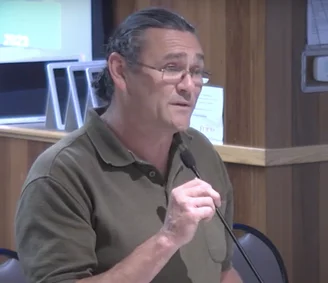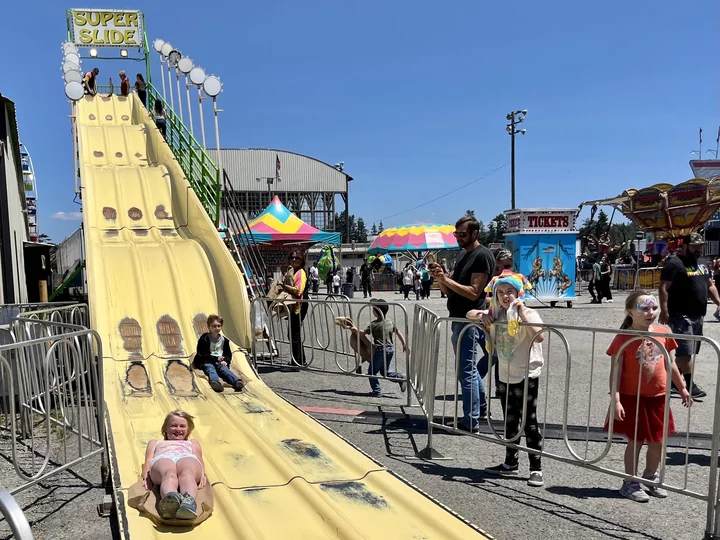VEGAS (AGAIN), BABY! Avelo Restores Service to Las Vegas With Twice-Weekly Direct Flights To/From ACV
LoCO Staff / Thursday, June 22, 2023 @ 9:07 a.m. / Airport
Break out the water cannons! File photo via Avelo.
PREVIOUSLY:
###
Press release from Avelo:
Avelo Airlines announced today it is returning exclusive nonstop service between the Humboldt Bay Area and Las Vegas. Avelo is once again the only airline offering nonstop service between California Redwood Coast-Humboldt County Airport (ACV) and Las Vegas’ Harry Reid International Airport (LAS).Introductory one-way fares between ACV and Las Vegas start at $49*. Customers can make reservations at AveloAir.com. Avelo will now serve two nonstop destinations from ACV: Las Vegas and Los Angeles.
Avelo Airlines Chairman and CEO Andrew Levy said, “We are excited to return exclusive nonstop service between the Humboldt Bay Area and the Entertainment Capital of the World. Our Redwood Coast Customers know Avelo is ACV’s most affordable and reliable airline. Flying to Vegas — whether for a week-long vacation or a spontaneous weekend getaway — is now easier than ever. Our Eureka and Arcata Customers told us they missed Avelo’s convenient, low-fare access to Vegas, and we listened.”
Avelo’s exclusive twice-weekly nonstop service between ACV and Las Vegas begins on September 8, 2023. Avelo will operate the flight on Mondays and Fridays utilizing Boeing Next-Generation (NG) 737 aircraft.
ACV Director of Aviation Cody M. Roggatz, C.M. said, “We are elated to have Avelo providing our region with direct service to Las Vegas! Their low fares, and exemplary customer service, will better connect Humboldt County to the World and the World to the Redwood Coast.”
BOOKED
Today: 6 felonies, 8 misdemeanors, 0 infractions
JUDGED
Humboldt County Superior Court Calendar: Today
CHP REPORTS
Sr299 W / Essex Ln Ofr (HM office): Traffic Hazard
44920 Willis Ave (HM office): Missing Indigenous
ELSEWHERE
County of Humboldt Meetings: Fish & Game Advisory Commission Agenda - Regular Meeting
Governor’s Office: TOMORROW: Governor Newsom and Mayor Lurie to announce new funding for homelessness and mental health efforts in San Francisco
Governor’s Office: Governor Newsom Proclaims Dr. Martin Luther King, Jr. Day 2026
Fishing the North Coast : Emerald water ahead as coastal rivers improve
California Child Care Providers Demand Raises From Gov. Newsom as Budget Deadline Looms
Jeanne Kuang / Thursday, June 22, 2023 @ 7:30 a.m. / Sacramento
State Sen. Eloise Gómez Reyes speaks to the crowd gathered for the Child Care Providers United rally at the state Capitol in Sacramento on June 15, 2023. Photo by Julie A Hotz for CalMatters.
The children who attend her home daycare in El Centro, in Imperial County near the Mexico border, are as young as 3 months old. Some are the children of farmworkers who drop them off at Guerrero’s house before their shifts in the pre-dawn hours. Nearly all are from families poor enough to qualify for state subsidies.
Many of the families can’t afford basic needs, Guerrero said, so the 57-year-old makes sure to provide their children with milk, diapers and sometimes clothes.
“I want the families to go to work knowing that (their children are) well taken care of, and they’re being loved and fed correctly,” she said.
Guerrero’s labor of love barely earns her a living. After paying two assistants and other costs, she figures she takes home about $3 or $4 an hour. She takes on credit card debt to keep her business going.
For years family child care providers — the vast majority of them women of color — have said they don’t get paid enough by the state of California to cover the costs of their businesses. Their fight for better pay and benefits, a two-decades-old effort, is reaching a fever pitch in California’s capital this year.
They’re pressing Gov. Gavin Newsom to raise their pay, and they have the Legislature on their side. Lawmakers put $1 billion for raises in their version of a state budget that they passed last week. That funding remains one of the key differences between Newsom and the Legislature as they hammer out a budget deal before July 1 that accounts for an estimated $32 billion deficit.
The full cost of California child care
Newsom deemed the child care industry critical to getting parents back to work and recovering the state’s economy from the pandemic. He signed legislation in 2019 allowing home child care providers like Guerrero to unionize and bargain with the state over subsidized child care reimbursement rates. And the state has issued multiple rounds of temporary stipends to providers who lost revenue during the pandemic.
But the 40,000-member union representing the home-based providers says Newsom’s administration isn’t offering providers enough to keep them in business long term. The union’s current contract expires in less than two weeks, at the end of June.
Bargaining for a new one this year, the union has called for a 25% bump in reimbursement rates the state pays to providers who care for low-income families’ kids — and state funding for the union to set up a trust to issue retirement benefits.
Providers staged a rally with about 2,000 members and supporters at the Capitol last week and plan to set up camp outside the Governor’s Mansion this week.
“As a direct result of their action, providers are gaining ground in negotiations towards pay increases and basic benefits — but we have yet to see a fair and just contract offer from the state,” said Max Arias, chairperson of the Child Care Providers’ Union, in a statement. “There appears to be no interest in committing to ongoing rate increases or covering the full cost of care.”
Family or home-based providers care for 28% of children who attend licensed facilities in California. Parents also send children to daycare centers or state-funded preschools, or pay a family member or friend.
A stopgap measure
To some advocates and members of the Legislative Women’s Caucus, even winning the raises would be only a stopgap measure to keep providers in business. The child care industry has experienced a slow recovery the past three year and still employs 5% fewer people than it did before the COVID-19 pandemic, according to a recent study by the UC Berkeley Center for the Study of Child Care Employment.
They’re pushing the state to move faster to fundamentally overhaul the way it calculates reimbursement rates. Sen. Monique Limón, a Democrat from Santa Barbara, authored a bill this year directing the state to overhaul the rates and provide the $1 billion raise in the meantime.
The $1 billion in the Legislature’s budget “solves an immediate problem,” she said. “It doesn’t solve the full, 10-year problem.”
The state’s reimbursement rates are generally tied to how much providers charge in the private market — but because many child care providers lower their prices to meet what parents can afford, the rates have ended up artificially low, in a system that a state-commissioned report last year described as a “market failure.” That in turn results in chronic shortages of child care for parents.
That report, on child care funding in California, was commissioned by a working group the state convened as part of its current contract with the child care union. In the report the national firm Prenatal to Five Fiscal Strategies, found California pays some daycare owners as little as a quarter of what the service costs.
A new model
In the southern region of the state, where Guerrero lives, the firm estimated it costs a home-based provider like hers more than $39,000 a year to provide quality care for one infant or toddler. The state reimburses about $12,000.
The same report recommended the state adopt a new method for calculating reimbursement rates that is based on real costs like the ones the firm calculated, rather than surveys of daycare rates. It has drawn support from both business and labor: a letter by the advocacy group Children Now urging the state to implement the recommendations was signed this year by the Service Employees International Union and the California Chamber of Commerce.
Asked to comment on the overhaul plan, both the state Department of Finance and the Department of Social Services said the issue is being negotiated with the child care union.
“Providers are gaining ground in negotiations towards pay increases and basic benefits — but we have yet to see a fair and just contract offer from the state.”
— Max Arias, chairperson of the Child Care Providers’ Union
No new payment method has been developed yet, though the state this year restarted the working group to advise on overhauling rates. Because the current rates are so low, a new model could be dramatically more expensive for the state. In some cases, providers may have to be paid three or four times what the state currently covers.
Advocates say it’s possible the state could come up with a new payment method that gradually, over several years, gets the pay closer to providers’ real costs.
Eric Peterson, director of client services and policy at Bananas, an Oakland agency that helps families find child care and subsidies to pay for it, sat on the working group that commissioned the cost report.
In nearly three decades in the field, Peterson said, pay for providers “has never been adequate.”
“Everybody knows… we can’t pay the true cost of care in a year,” he said. “The intent is to acknowledge the true cost and find a schedule to get there.”
###
CalMatters.org is a nonprofit, nonpartisan media venture explaining California policies and politics.
Eureka City Council Replaces Old Code of Conduct Handbook With New, ‘Less Problematic’ Version Amid Accusations of Ethics Violations From Some Members of the Public
Isabella Vanderheiden / Wednesday, June 21, 2023 @ 4:59 p.m. / Local Government
Screenshot of Tuesday’s Eureka Council meeting.
###
The Eureka City Council voted Tuesday to rescind and replace its “Councilmember Handbook” to address mounting concerns from some members of the public who allege that members of the council have violated the city’s code of conduct.
The policy contained in the new “Handbook” reinforces existing rules from state and federal entities that guide ethics and conduct standards for public officials.
The issue came about earlier this year when Eureka business owner Roy Gomez filed a claim for damages against the City of Eureka. The claim, in part, accused the city council of violating the city’s “Code of Ethics and Conduct for Elected and Appointed Officials.” Gomez had claimed that Councilmember Leslie Castellano, specifically, had violated the ethics policy in various ways after she, in her capacity as the executive director of the Ink People Center for the Arts, declined to assign a special event permit to sell alcohol at a function at Gomez’s former event venue, Forever Found.
Gomez has openly discussed his claims against the city during the non-agenda public comment portion of several recent city council meetings, going so far as to accuse several members of the council of being “undemocratic anarchists” seeking to dismantle capitalism.
During Tuesday’s meeting, Assistant City Manager Pam Powell detailed the history of the city’s existing code of conduct, which was adopted in a narrow 3-2 vote by a previous council in May of 2017. The two dissenting council members questioned some of the provisions included in the code, and one of the council members refused to sign the document entirely. Former Eureka Mayor Frank Jager signed the document but rescinded his signature in 2018. “Once the mayor rescinded his signature, staff was kind of in a predicament over how we could enforce this document,” she said.
“The main issue with the document were First Amendment concerns,” Powell continued. “The document did not allow for the mayor, councilmembers, or board and commission members to use their title when endorsing a political candidate. Staff’s concerns centered on the enforceability of the document.”
Powell added that the document included provisions that gave the mayor “more power than the charter actually allows.” In fact, staff reported, the policies in the Handbook were never adopted into the city charter or its ordinances — they merely served as a voluntary set of guidelines that previous councilmembers could follow or not.
The code of conduct was not provided to new council members following the November 2018 election. However, staff worked with the former city attorney and city manager to ensure that the mayor and council followed rules outlined by California’s Fair Political Practices Commission (FPPC) and Assembly Bill 1234, which required elected officials to take an ethics course every two years.
Powell noted that “many elements” of the 2017 code of conduct document are included in the new handbook, including concepts of respect, staff relationships, rules, conflict of interest and ethics. “The new handbook does not contain any provisions regarding council members and their use of titles should they support a political candidate,” she said. “Staff believes that the council handbook confirms the city’s commitment to strong ethics and transparency.”
Councilmember Kati Moulton asked what is covered in the city’s handbook that isn’t already required by the FPPC or other existing laws surrounding ethics and conflict of interest.
“I would agree with [Powell] that the things that are in the old code that aren’t in this new handbook are what we would consider somewhat problematic portions around whether or not city council members can use their title in supporting other candidates,” City Attorney Autumn Luna responded. “We didn’t think it was appropriate for the new code.”
Even so, Councilmember Renee Contreras-DeLoach asked if the city had an obligation to enforce the rules outlined in the document. Luna said she would not feel comfortable enforcing “questionable regulations against the council,” adding that the document “doesn’t have the force of law.”
“Let’s just remember that, hierarchically, we have really important and complex laws coming from the state and coming from the FPPC,” Luna continued. “I don’t mean to drive this home too many times, but you are not setting conflict of interest rules for yourself and then rescinding them. Those rules are set elsewhere in the law, and you follow them because of that. Not because of a resolution [that was] passed by a different counsel at a different time.”
During the public comment portion of the discussion, Gomez criticized the city’s decision to ignore its own code of ethics. He asserted that the proposed handbook has “no actual teeth to it” and urged the council to amend the existing document.
“The one being rescinded … there’s accountability within it,” he said. “It’s important that we realize that the violations have been occurring because there’s been no code of ethics. You can’t just say, ‘Oh, I submitted a Form 700 and we’re good.’ Like, there are ongoing conflicts of interest on a daily basis. … To be honest with you, I actually agree that the council members should be okay with endorsing [candidates]. Why not just rescind that piece out of it and then leave it as it is? It’s a good document as it is.”
(Note: Form 700 is a document used by public officials to disclose financial interests to ensure the public is aware of a public official’s financial interests and remind the public official of potential conflicts, according to the FPPC.)
Eureka resident Ash Teeter questioned the timing of the code of conduct update accused the city council of “changing the rules of the game that [it] might already be cheating in” and echoed Gomez’s previous claims that the council is a group of anarchists.
“Multiple city council members … support dismantling capitalism, anarchy and are affiliated with extremist groups like Antifa on their Twitter pages, as I found,” Teeter said. “It’s like they’re playing both sides of the game … sitting on the council chambers by day, plotting the downfall of the system by night.”
Arcata resident Jessica Frint said she did not intend to speak during public comment but felt compelled to after she heard Moulton swear under her breath during Teeter’s comments.
“When [he] asked her a question, she replied, ‘You asshole,’” Frint said. “If we have a code of conduct, I would assume that’s a violation. I would like to see you do something about it. … Or whoever is responsible for doing something about it, do something about it. That’s bad behavior.”
Following public comment, Moulton began to apologize for her “outburst” but was met with shouting from Gomez in the audience. Mayor Bergel interjected and requested that the council take a five-minute break.
Upon the council’s return, Contreras-DeLoach said she watched the May 2, 2017 city council meeting to better understand the history of the city’s code of conduct policy before voting on the matter. “And I feel very comfortable saying that I think the document is a redundant document,” she said.
“These are laws that already exist,” she continued. “These are things that we’re already held to, trainings we’ve already done, they’re things that we’ve already signed or stuff that we have to declare. … I don’t have any concerns moving forward with this.”
Contreras-DeLoach also acknowledged the public’s concerns surrounding the timing of the item.
“I acknowledge that doesn’t look great … [but] I think this is one of those things where, unfortunately, sometimes the veneer of something just gives you the wrong impression,” she said. “If someone doesn’t take the time to listen to what we’re saying or to look at these documents or to watch that council meeting, they may walk away from this thinking … we want to disband or abolish some code of ethics when in reality we’re held by much bigger laws.”
Contreras-DeLoach made a motion to approve staff’s recommendation to replace the ethics handbook with the new proposed document. Moulton offered a second to the action, as well as an apology.
“Thank you, Councilmember Contreras DeLoach for articulating what I was too heated to say,” Moulton said. “I want to apologize again to the mayor, Mr. Teeter and to the public for losing my cool and lowering the discourse when we should be elevating the discourse with information and with perspective.”
Before taking a vote, Councilmember Leslie Castellano noted that it isn’t out of the ordinary for the city council to repeal and replace documents.
“This is a fairly normal and natural part of city government,” she said. “You know, as we learn and grow as a populace we repeal and replace things and that’s healthy democracy. … I personally think that there are many reasons that problematic documents are changed … Often those are brought to our attention by citizens in various ways. This is also one of those instances where a citizen brought forward something that was problematic and we have an opportunity to change it.”
Councilmember G. Mario Fernandez echoed Castellano’s comments and said he felt comfortable moving ahead with the new document.
Councilmember Scott Bauer took a moment to dispute previous accusations that members of the council have anarchist affiliations, noting that the council had passed a budget earlier in the evening “that fully funds our police force and our firefighters.”
The motion passed in a unanimous 5-0 vote.
###
Other notable bits from Tuesday’s meeting:
- The city council unanimously approved the proposed budget for fiscal year 2023-24. Eureka’s Finance Director Lane Millar pointed out a few minor modifications to the proposed budget during a presentation to the council, including a request to transfer $9,000 in non-departmental funds to the mayor and council’s division for future town halls. Millar also discussed several potential investment opportunities through the state and federal governments which will be further discussed at a date uncertain.
- The city council approved a 10.44 percent rate increase for trash collection in Eureka in a 4-1 vote, with Fernandez dissenting.
- The council gave Public Works Director Brian Gerving the green light to accept a $5 million grant on behalf of the City of Eureka for a restoration project to enhance fish passage in a stream between Myrtle Avenue and Fourteenth Street. The item passed in a unanimous 4-0, with Bauer recusing himself.
YAY! IT’S FAIR TIME: Annual Redwood Acres Fair Kicks Off Today, Raceway’s ‘Hillbilly Boat Race’ Returns This Weekend
Stephanie McGeary / Wednesday, June 21, 2023 @ 4:59 p.m. / Our Culture
Ah..the familiar ferris wheel means summer fun has begun! Redwood Acres Fair on opening day | Photos: Stephanie McGeary, except where noted
Whoohoo! It’s officially the first day of summer, which means that it’s not only the longest day of the year, but also the start of fair season! And the event that always kicks it off – Redwood Acres Fair – was in full swing on its opening day, upholding the annual fair’s 2023 theme: “Summer Starts Here.”
All of the things that you would usually expect were there – greasy funnel cakes, cotton candy and other standard fair fare, lots of livestock and other animals, toy trains, somewhat unsafe-looking rides and, of course, carnival games that are usually almost impossible to win.
Though the fair seemed noticeably less packed on opening day than it was in 2022 (likely because the fair offered free admission on opening day last year), there were still plenty of people out enjoying the splendidly sunny Humboldt day at Redwood Acres. And, hey, less people means shorter lines for the food, tickets and rides!
Of course, things will probably pick up quite a bit over the weekend, especially on Friday evening when stock car racing takes place on the Redwood Acres Raceway (4 to 11 p.m.) The fair also added another special event to this year’s racing, turning Saturday into Motorsports Night. It’ll feature sports car drag racing from the Redwood Sports Car Club and “slideways exhibition” put on by Grassroots Drifting.
The main event of motorsports night will be the Down & Dirty Hillbilly Boat Race – where the race cars drag speed boats behind them and attempt to dislodge the boats of their competitors. According to a press release sent out by Redwood Acres, this will be the first boat race at Redwood Acres since 2016. The races are free with admission to the fair.
“The twist to bringing boat races back will be that the event will be run on the infield of the 3/8-mile track,” the release states. “The main reason boat races have been off the schedule for so long was because of the damage the events did to the racing surface. Boat racing in the dirt should add an all new and exciting challenge to the action that fans will not want to miss out on.”
You can find more information, rules for the boat race and footage of past boat races on the Redwood Acres Raceway Facebook Page. Redwood Acres Fair runs from June 21-25, from noon to midnight. You can find more info on Redwood Acres’ website.
Scroll down for more photos of the fun on opening day!
You could dunk a cop!
“The Birdman” show, featuring a giant Andean condor
the French Quarter in Eureka? these kids seem to enjoy it
Camels and a zebra!
hey! who took my fries?
gotta get a soft serve
One Man Dead, Another Suffers Major Injuries After Car Plummets 200 Feet Off Embankment on Scenic Drive Near Trinidad
LoCO Staff / Wednesday, June 21, 2023 @ 2:08 p.m. / Traffic
PREVIOUSLY: SCANNER TRAFFIC INDICATES: Car Over the Side Off Scenic Drive
###
Press release from the California Highway Patrol:
On June 21, 2023, at approximately [10:20 a.m.], CHP Humboldt Communications Center received a report of a vehicle off the roadway, and down a steep embankment, on Scenic Dr., north of Baker Ranch Rd. in Trinidad.
Emergency personnel responded to the scene and located a
20232003 Toyota Camry approximately 200 feet down a steep embankment.Two unidentified males were located inside the vehicle. One party was determined by medical personnel on scene to be deceased. The second party was extricated and transported to the hospital with major injuries.
At this time, it is unknown exactly when this crash may have occurred.
The CHP Humboldt Area office is continuing its investigation and asks anyone who may have additional information to contact the California Highway Patrol at 707-822-5981.
Pounds and Pounds of Meth Found in Fortuna Man’s Possession After Weeks-Long Investigation, Drug Task Force Says
LoCO Staff / Wednesday, June 21, 2023 @ 10:43 a.m. / Crime
Photos: Humboldt County Drug Task Force.
Press release from the Humboldt County Drug Task Force:
On June 20, 2023, Humboldt County Drug Task Force Agents and Officers with the Fortuna Police Department served a multi-location search warrant at a residence located in the 500 block of Francesco Place in Fortuna, a storage unit in the 1000 block of Airport Rd. in Fortuna and on the person of Heriberto Posos Cantu (age 37). After a multi-week investigation, the HCDTF believed Posos Cantu was in possession of large quantities of methamphetamine for the purpose of sales.
HCDTF Agents and FPD Officers responded to Heriberto’s storage unit on Airport Road. Upon their arrival Fortuna Police Officer [Dennis] Stevens and his K9 Partner Cain conducted an open-air sniff inside of the storage unit. K9 Cain alerted on several locations inside of the storage unit indicating that narcotics or firearms were hidden inside. Agents searched the storage unit and located approximately five pounds of methamphetamine, packaging materials and indicia for Posos Cantu.
After Agents were finished searching the storage unit, they responded to Posos Cantu’s residence in the 500 block of Francesco Place. As Agents were approaching Posos Cantu’s residence, a vehicle was seen backing out of the driveway. Agents conducted a traffic stop on the vehicle and three subjects were detained.
Fortuna PD Officer Stevens and his K9 partner Cain conducted an open-air sniff around the vehicle. K9 Cain alerted on the vehicle, indicating that narcotics or firearms were hidden inside. Agents searched the vehicle and located approximately seven pounds of methamphetamine.
It was later determined that Posos Cantu learned that law enforcement was serving a search warrant on his properties. Upon receiving that information, Posos Cantu called a family member and requested that they remove the methamphetamine from the residence prior to law enforcement’s arrival.
Agents searched Posos Cantu’s residence where they located more packaging material, a digital scale and approximately $10,000 in US Currency. As Agents were conducting their investigation at the residence, Posos Cantu arrived on scene. Posos Cantu was placed under arrest without incident.
Posos Cantu was transported to the Humboldt County Correctional Facility where he was booked for the following charge:
- 11378 HS Possession of a controlled substance for the purpose of sales
- Anyone with information related to this investigation or other narcotics related crimes are encouraged to call the Humboldt County Drug Task Force at 707-267-9976.
Justice Samuel Alito Took Luxury Fishing Vacation With GOP Billionaire Who Later Had Cases Before the Court — With Help From Eureka’s Rob Arkley
Justin Elliott, Joshua Kaplan and Alex Mierjeski / Wednesday, June 21, 2023 @ 7:37 a.m. / D.C.
Photo obtained by ProPublica.
###
This story was originally published by ProPublica. ProPublica is a Pulitzer Prize-winning investigative newsroom. Sign up for The Big Story newsletter to receive stories like this one in your inbox.
###
In early July 2008, Samuel Alito stood on a riverbank in a remote corner of Alaska. The Supreme Court justice was on vacation at a luxury fishing lodge that charged more than $1,000 a day, and after catching a king salmon nearly the size of his leg, Alito posed for a picture. To his left, a man stood beaming: Paul Singer, a hedge fund billionaire who has repeatedly asked the Supreme Court to rule in his favor in high-stakes business disputes.
Singer was more than a fellow angler. He flew Alito to Alaska on a private jet. If the justice chartered the plane himself, the cost could have exceeded $100,000 one way.
In the years that followed, Singer’s hedge fund came before the court at least 10 times in cases where his role was often covered by the legal press and mainstream media. In 2014, the court agreed to resolve a key issue in a decade-long battle between Singer’s hedge fund and the nation of Argentina. Alito did not recuse himself from the case and voted with the 7-1 majority in Singer’s favor. The hedge fund was ultimately paid $2.4 billion.
Alito did not report the 2008 fishing trip on his annual financial disclosures. By failing to disclose the private jet flight Singer provided, Alito appears to have violated a federal law that requires justices to disclose most gifts, according to ethics law experts.
Experts said they could not identify an instance of a justice ruling on a case after receiving an expensive gift paid for by one of the parties.
“If you were good friends, what were you doing ruling on his case?” said Charles Geyh, an Indiana University law professor and leading expert on recusals. “And if you weren’t good friends, what were you doing accepting this?” referring to the flight on the private jet.
Series: Friends of the Court
Clarence Thomas’ Beneficial Friendship With a GOP Megadonor
Justices are almost entirely left to police themselves on ethical issues, with few restrictions on what gifts they can accept. When a potential conflict arises, the sole arbiter of whether a justice should step away from a case is the justice him or herself.
ProPublica’s investigation sheds new light on how luxury travel has given prominent political donors — including one who has had cases before the Supreme Court — intimate access to the most powerful judges in the country. Another wealthy businessman provided expensive vacations to two members of the high court, ProPublica found. On his Alaska trip, Alito stayed at a commercial fishing lodge owned by this businessman, who was also a major conservative donor. Three years before, that same businessman flew Justice Antonin Scalia, who died in 2016, on a private jet to Alaska and paid the bill for his stay.
Such trips would be unheard of for the vast majority of federal workers, who are generally barred from taking even modest gifts.
Leonard Leo, the longtime leader of the conservative Federalist Society, attended and helped organize the Alaska fishing vacation. Leo invited Singer to join, according to a person familiar with the trip, and asked Singer if he and Alito could fly on the billionaire’s jet. Leo had recently played an important role in the justice’s confirmation to the court. Singer and the lodge owner were both major donors to Leo’s political groups.
ProPublica’s examination of Alito’s and Scalia’s travel drew on trip planning emails, Alaska fishing licenses, and interviews with dozens of people including private jet pilots, fishing guides, former high-level employees of both Singer and the lodge owner, and other guests on the trips.
ProPublica sent Alito a list of detailed questions last week, and on Tuesday, the Supreme Court’s head spokeswoman told ProPublica that Alito would not be commenting. Several hours later, The Wall Street Journal published an op-ed by Alito responding to ProPublica’s questions about the trip.
Alito said that when Singer’s companies came before the court, the justice was unaware of the billionaire’s connection to the cases. He said he recalled speaking to Singer on “no more than a handful of occasions,” and they never discussed Singer’s business or issues before the court.
Alito said that he was invited to fly on Singer’s plane shortly before the trip and that the seat “would have otherwise been vacant.” He defended his failure to report the trip to the public, writing that justices “commonly interpreted” the disclosure requirements to not include “accommodations and transportation for social events.”
In a statement, a spokesperson for Singer told ProPublica that Singer didn’t organize the trip and that he wasn’t aware Alito would be attending when he accepted the invitation. Singer “never discussed his business interests” with the justice, the spokesperson said, adding that at the time of trip, neither Singer nor his companies had “any pending matters before the Supreme Court, nor could Mr. Singer have anticipated in 2008 that a subsequent matter would arise that would merit Supreme Court review.”
Leo did not respond to questions about his organizing the trip but said in a statement that he “would never presume to tell” Alito and Scalia “what to do.”
This spring, ProPublica reported that Justice Clarence Thomas received decades of luxury travel from another Republican megadonor, Dallas real estate magnate Harlan Crow. In a statement, Thomas defended the undisclosed trips, saying unnamed colleagues advised him that he didn’t need to report such gifts to the public. Crow also gave Thomas money in an undisclosed real estate deal and paid private school tuition for his grandnephew, who Thomas was raising as a son. Thomas reported neither transaction on his disclosure forms.
The undisclosed gifts have prompted lawmakers to launch investigations and call for ethics reform. Recent bills would impose tighter rules for justices’ recusals, require the Supreme Court to adopt a binding code of conduct and create an ethics body, which would investigate complaints. Neither a code nor an ethics office currently exists.
“We wouldn’t tolerate this from a city council member or an alderman,” Sen. Dick Durbin, an Illinois Democrat and chair of the Senate Judiciary Committee, said of Thomas in a recent hearing. “And yet the Supreme Court won’t even acknowledge it’s a problem.”
So far, the court has chafed at the prospect of such reforms. Though the court recently laid out its ethics practices in a statement signed by all nine justices, Chief Justice John Roberts has not directly addressed the recent revelations. In fact, he has repeatedly suggested Congress might not have the power to regulate the court at all.
“We Take Good Care of Him Because He Makes All the Rules”
In the 1960s in his first year at Harvard Law School, Singer was listening to a lecture by a famed liberal professor when, he later recalled, he had an epiphany: “My goodness. They’re making it up as they go along.”
It was a common sentiment among conservative lawyers, who often accuse liberal judges of activist overreach. While Singer’s career as an attorney was short-lived, his convictions about the law stayed with him for decades. After starting a hedge fund that eventually made him one of the richest people in the country, he began directing huge sums to causes on the right. That included groups, like the Federalist Society, dedicated to fostering the conservative legal movement and putting its followers on the bench.
Other guests on the trip included Leo, the Federalist Society leader, and Judge A. Raymond Randolph, a prominent conservative appellate judge for whom Leo had clerked, according to fishing licenses and interviews with lodge staff.
On another day, the group flew on one of the lodge’s bush planes to a waterfall in Katmai National Park, where bears snatch salmon from the water with their teeth. At night, the lodge’s chefs served multicourse meals of Alaskan king crab legs or Kobe filet. On the last evening, a member of Alito’s group bragged that the wine they were drinking cost $1,000 a bottle, one of the lodge’s fishing guides told ProPublica.
In his op-ed, Alito described the lodge as a “comfortable but rustic facility.” The justice said he does not remember if he was served wine, but if he was, it didn’t cost $1,000 a bottle. (Alito also pointed readers to the lodge’s website. The lodge has been sold since 2008 and is now a more downscale accommodation.)
Arkley. Outpost file photo, 2013.
The justice’s stay was provided free of charge by another major donor to the conservative legal movement: Robin Arkley II, the owner of a mortgage company then based in California. Arkley had recently acquired the fishing lodge, which catered to affluent tourists seeking a luxury experience in the Alaskan wilderness. A planning document prepared by lodge staff describes Alito as a guest of Arkley. Another guest on the trip told ProPublica the trip was a gift from Arkley, and two lodge employees said they were told that Alito wasn’t paying.
Arkley, who does not appear to have been involved in any cases before the court, did not respond to detailed questions for this story.
In the last decade, Singer has contributed over $80 million to Republican political groups. He has also given millions to the Manhattan Institute, a conservative think tank where he has served as chairman since 2008. The institute regularly files friend-of-the-court briefs with the Supreme Court — at least 15 this term, including one asking the court to block student loan relief.
Singer’s interest in the courts is more than ideological. His hedge fund, Elliott Management, is best known for making investments that promise handsome returns but could require bruising legal battles. Singer has said he’s drawn to positions where you “control your own destiny, not just riding up and down with the waves of financial markets.” That can mean pressuring corporate boards to fire a CEO, brawling with creditors over the remains of a bankrupt company and suing opponents.
The fund now manages more than $50 billion in assets. “The investments are extremely shrewdly litigation-driven,” a person familiar with Singer’s fund told ProPublica. “That’s why he’s a billionaire.”
Singer’s most famous gamble eventually made its way to the Supreme Court.
In 2001, Argentina was in a devastating economic depression. Unemployment skyrocketed and deadly riots broke out in the street. The day after Christmas, the government finally went into default. For Singer, the crisis was an opportunity. As other investors fled, his fund purchased Argentine government debt at a steep discount.
Within several years, as the Argentine economy recovered, most creditors settled with the government and accepted a fraction of what the debt was originally worth. But Singer’s fund, an arm of Elliott called NML Capital, held out. Soon, they were at war: a midtown Manhattan-based hedge fund trying to impose its will on a sovereign nation thousands of miles away.
The fight played out on familiar turf for Singer: the U.S. courts. He launched an aggressive legal campaign to force Argentina to pay in full, and his personal involvement in the case attracted widespread media attention. Over 13 years of litigation, the arguments spanned what rights foreign governments have in the U.S. and whether Argentina could pay off debts to others before Singer settled his claim.
If Singer succeeded, he stood to make a fortune.
In 2007, for the first but not the last time, Singer’s fund asked the Supreme Court to intervene. A lower court had stopped Singer and another fund from seizing Argentine central bank funds held in the U.S. The investors appealed, but that October, the Supreme Court declined to take up the case.
Photo obtained by ProPublica.
On July 8 of the following year, Singer took Alito to Alaska on the private jet, according to emails, flight data from the Federal Aviation Administration and people familiar with the trip.
The group flew across the country to the town of King Salmon on the Alaska peninsula. They returned to the East Coast three days later.
In Alaska, they stayed at the King Salmon Lodge, a luxury fishing resort that drew celebrities, wealthy businessmen and sports stars. On July 9, one of the lodge’s pilots flew Alito and other guests around 70 miles to the west to fish the Nushagak River, known for one of the best salmon runs in the world. Snapshots from the trip show Alito in waders and an Indianapolis Grand Prix hat, smiling broadly as he holds his catch.
“Sam Alito is in the red jacket there,” one lodge worker said, as he narrated an amateur video of the justice on the water. “We take good care of him because he makes all the rules.”
“The exception only covers food, lodging and entertainment,” said Virginia Canter, a former government ethics lawyer now at the watchdog group CREW. “He’s trying to move away from the plain language of the statute and the regulation.”
The Alaska vacation was the first time Singer and Alito met, according to a person familiar with the trip. After the trip, the two appeared together at public events. When Alito spoke at the annual dinner of the Federalist Society lawyers convention the following year, the billionaire introduced him. The justice told a story about having an encounter with bears during a fishing trip with Singer, according to the legal blog Above the Law. He recalled asking himself: “Do you really want to go down in history as the first Supreme Court justice to be devoured by a bear?”
The year after that, in 2010, Alito delivered the keynote speech at a dinner for donors to the Manhattan Institute. Once again, Singer delivered a flattering introduction. “He and his small band of like-minded justices are a critical and much-appreciated bulwark of our freedom,” Singer told the crowd. “Samuel Alito is a model Supreme Court justice.”
Alito did not disclose the flight or the stay at the fishing lodge in his annual financial disclosures. A federal law passed after Watergate requires federal officials including Supreme Court justices to publicly report most gifts. (The year before, Alito reported getting $500 of Italian food and wine from a friend, noting that his friend was unlikely to “appear before this Court.”)
The law has a “personal hospitality” exemption: If someone hosts a justice on their own property, free “food, lodging, or entertainment” don’t always have to be disclosed. But the law clearly requires disclosure for gifts of private jet flights, according to seven ethics law experts, and Alito appears to have violated it. The typical interpretation of the law required disclosure for his stay at the lodge too, experts said, since it was a commercial property rather than a vacation home. The judiciary’s regulations did not make that explicit until they were updated earlier this year.
In his op-ed, Alito said that justices “commonly interpreted” the law’s exception for hospitality “to mean that accommodations and transportation for social events were not reportable gifts.”
His op-ed pointed to language in the judiciary’s filing instructions and cited definitions from Black’s Law Dictionary and Webster’s. But he did not make reference to the judiciary’s regulations or the law itself, which experts said both clearly required disclosure for gifts of travel. ProPublica found at least six examples of other federal judges disclosing gifts of private jet travel in recent years.
Meanwhile, Singer and Argentina kept asking the Supreme Court to intervene in their legal fight. His fund enlisted Ted Olson, the famed appellate lawyer who represented George W. Bush in the Bush v. Gore case during the 2000 presidential election.
In January 2010, a year and a half after the Alaska vacation, the fund once again asked the high court to take up an aspect of the dispute. The court declined. In total, parties asked the court to hear appeals in the litigation eight times in the six years after the trip. In most instances, it was Singer’s adversaries filing an appeal, with Singer’s fund successfully arguing for the justices to decline the case and let stand a lower court ruling.
The Supreme Court hears a tiny portion of the many cases it’s asked to rule on each year. Under the court’s rules, cases are only accepted when at least four of the nine justices vote to take it up. The deliberations on whether to take a case are shrouded in secrecy and happen at meetings attended only by the justices. These decisions are a fundamental way the court wields power. The justices’ votes are not typically made public, so it is unclear how Alito voted on the petitions involving Singer.
As Singer’s battle with Argentina intensified, his hedge fund launched an expansive public relations and lobbying campaign. In 2012, the hedge fund even attempted to seize an Argentine navy ship docked in Ghana to secure payment from the country. (The effort was thwarted by a ruling from the International Tribunal for the Law of the Sea.) Argentina’s president labeled Singer and his fellow investors “vultures” attempting extortion; Singer complained the country was scapegoating him.
In 2014, the Supreme Court finally agreed to hear a case on the matter. It centered on an important issue: how much protection Argentina could claim as a sovereign nation against the hedge fund’s legal maneuvers in U.S. courts. The U.S. government filed a brief on Argentina’s side, warning that the case raised “extraordinarily sensitive foreign policy concerns.”
The case featured an unusual intervention by the Judicial Crisis Network, a group affiliated with Leo known for spending millions on judicial confirmation fights. The group filed a brief supporting Singer, which appears to be the only Supreme Court friend-of-the-court brief in the organization’s history.
The court ruled in Singer’s favor 7-1 with Alito joining the majority. The justice did not recuse himself from the case or from any of the other petitions involving Singer.
“The tide turned” thanks to that “decisive” ruling and another from the court, as Singer’s law firm described it. After the legal setbacks and the election of a new president in Argentina, the country finally capitulated in 2016. Singer’s fund walked away with a $2.4 billion payout, a spectacular return.
Abbe Smith, a law professor at Georgetown who co-wrote a textbook on legal and judicial ethics, said that Alito should have recused himself. If she were representing a client and learned the judge had taken a gift from the party on the other side, Smith said, she would immediately move for recusal. “If I found out after the fact, I’d be outraged on behalf of my client,” she said. “And, frankly, I’d be outraged on behalf of the legal system.”
The law that governs when justices must recuse themselves from a case sets a high but subjective standard. It requires justices to withdraw from any case when their “impartiality might reasonably be questioned.” But the court allows individual justices to interpret that requirement for themselves. Historically, they’ve almost never explained why they are or are not recusing themselves, and unlike lower court judges, their decisions cannot be appealed.
Alito articulated his own standard during his Senate confirmation process, writing that he believed in stepping away from cases when “any possible question might arise.”
In his Wall Street Journal op-ed, Alito wrote of his failure to recuse himself from Singer’s cases at the court: “It was and is my judgment that these facts would not cause a reasonable and unbiased person to doubt my ability to decide the matters in question impartially.”
Critics have long assailed the Supreme Court’s practices on this issue as both opaque and inconsistent. “The idea ‘just trust us to do the right thing’ while remaining in total secrecy is unworkable,” said Amanda Frost, a judicial ethics expert at the University of Virginia School of Law.
For Singer, appeals to the Supreme Court are an almost unavoidable result of his business model. Since the Argentina case, Singer’s funds were named parties in at least two other cases that were appealed to the court, both stemming from battles with Fortune 500 companies. One of the petitions is currently pending.
Leonard Leo, center, on the 2008 fishing trip with a guide and other guests. Leo attended and helped organize the Alaska fishing vacation. Photo obtained by ProPublica.
Grey Goose and Glacier Ice
The month after Singer got home from the 2008 fishing trip, he realized he had a problem. He was supposed to receive a shipment of frozen salmon from the Alaska lodge. But the fish hadn’t arrived. So the billionaire emailed an unlikely person to get to the bottom of it: Leo, the powerful Federalist Society executive.
“They’ve escaped!!” Singer wrote. Leo then sent an email to Arkley, the lodge owner, to track down the missing seafood.
The only clear thread connecting the prominent guests on the trip is that they all had a relationship with Leo. Leo is now a giant in judicial politics who helped handpick Donald Trump’s list of potential Supreme Court nominees and recently received a $1.6 billion donation to further his political interests. Leo’s network of political groups was in its early days, however, when he traveled with Alito to Alaska. It had run an advertising campaign supporting Alito in his confirmation fight, and Leo was reportedly part of the team that prepared Alito for his Senate hearings.
Singer and Arkley, the businessmen who provided the trip to the justice, were both significant donors to Leo’s groups at the time, according to public records and reporting by The Daily Beast. Arkley also sometimes provided Leo with one of his private planes to travel to business meetings, according to a former pilot of Arkley’s.
In his statement, Leo did not address detailed questions about the trip, but he said “no objective and well-informed observer of the judiciary honestly could believe that they decide cases in order to cull favor with friends, or in return for a free plane seat or fishing trip.”
He added that the public should wonder whether ProPublica’s coverage is “bait for reeling in more dark money from woke billionaires who want to damage this Supreme Court and remake it into one that will disregard the law by rubber stamping their disordered and highly unpopular cultural preferences.”
Arkley is a fixture in local politics in his hometown of Eureka, California, known for lashing out at city officials and for once starting his own newspaper reportedly out of disdain for the local press. By the early 2000s, he’d made a fortune buying and servicing distressed mortgages and also become a significant donor in national GOP politics.
As his political profile rose, Arkley bragged to friends that he’d gotten to know one-third of the sitting Supreme Court justices. He told friends he had a relationship with Clarence Thomas, according to two people who were close with Arkley. And the Alito trip was not Arkley’s first time covering a Supreme Court justice’s travel to Alaska.
In June 2005, Arkley flew Scalia on his private jet to Kodiak Island, Alaska, two of Arkley’s former pilots told ProPublica. Arkley had paid to rent out a remote fishing lodge that cost $3,200 a week per person, according to the lodge’s owner, Martha Sikes.
Snapshots from the trip, found in the justice’s papers at Harvard Law School, capture Scalia knee-deep in a river as he fights to reel in a fish. Randolph, the appellate judge who was also on the later trip, joined Scalia and Arkley on the vacation, flying on the businessman’s jet.
Scalia did not report the trip on his annual filing, another apparent violation of the law, according to ethics law experts. Scalia’s travels briefly drew scrutiny in 2016 after he died while staying at the hunting ranch of a Texas businessman. Scalia had a pattern of disclosing trips to deliver lectures while not mentioning hunting excursions he took to nearby locales hosted by local attorneys and businessmen, according to a research paper published after his death.
Randolph, now a senior judge on the U.S. Court of Appeals for the D.C. Circuit, did not disclose the trip. (Nor did he disclose the later trip with Alito.) Randolph told ProPublica that when he was preparing his form for 2005, he called the judiciary’s financial disclosure office to ask about disclosing the trip. He shared his notes from the call with a staffer, which say “don’t have to report trip to Alaska with Rob Arkley & others / private jet / lodge.” Kathleen Clark, an ethics law expert at Washington University in St. Louis, said, “I don’t understand how the staff member came to that conclusion based on the language in the statute.”
On June 9, Arkley’s group chartered a boat, the Happy Hooker IV, to tour Yakutat Bay. On the way over, Scalia and Arkley discussed whether Senate Republicans, then in a contentious fight over judicial confirmations, should abolish the filibuster to move forward, according to a person traveling with them.
A photo captures Arkley and Scalia later that day gazing off the side of the boat at the famed Hubbard Glacier. At one point, a guide chiseled chunks off an iceberg and passed them to Scalia. The justice then mixed martinis from Grey Goose vodka and glacier ice.
It remains unclear how Scalia ended up in Alaska with Arkley. But the justice’s archives at Harvard Law School offer a tantalizing clue. Immediately before the fishing trip, Scalia gave a speech for the Federalist Society in Napa, California. The next day, Arkley’s plane flew from Napa to Alaska. Scalia’s papers contain a folder labeled “Federalist Society, Napa and Alaska, 2005 June 3-10,” suggesting a possible connection between the conservative organization and the fishing trip.
The contents of that folder are currently sealed, however. They will be opened to the public in 2036.






























